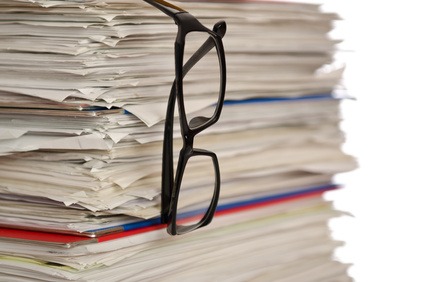
Managing Your Reading Materials
One of the most popular questions I get from clients and workshop attendees is how to handle the plethora of “things to read” we receive on a daily basis. This could include magazines, articles, books, email newsletters, internet-based information, or educational materials received from conferences or workshops. We collect these materials for many reasons, including:
As someone who loves to read for business and pleasure, and strives to stay on top of the latest news, tools and information in my industry, I have also struggled with how to manage all of the related information. The next two Simpler Times will share techniques for dealing with this often overwhelming piece of information management. This month I will discuss general tips for managing your reading materials and share tools specifically for paper information. Next month, I will focus on tips and tools for reading information that is in electronic form.
Steps for management of reading and educational materials:
1. Gather all of your materials in one place, or make a list if that is not feasible. Sort by priority and context. For example, is it leisure reading? Is it strictly educational? Is it related to a current project? Or is it related to a project you would like to do in the future?
2. Acknowledge that you can’t read everything. Unsubscribe from magazines and newsletters that don’t provide you value. Delete or recycle information that doesn’t apply to your personal or professional vision and goals. Consider selling books at a resale store such as Half-Price Books or on www.Amazon.com. The more you can declutter your reading materals, keeping only those that apply to your current values and goals, the less stress and overwhelm you will feel.
3. Determine how and where you will store your information.
- Books and binders should be stored on a bookcase in a format that works best for you. Perhaps this is by reading type, or alphabetically. You might have a different location for books that are current reading or those you plan to read within the next 30 days.
- Magazines can be stored in magazine files on a bookcase or within a hanging filing system if they are not too large. These may also be stored by type or alphabetically. Those relating to a specific project might be stored with that project file. Magazines that are kept for leisure reading can be stored in basket or bin near where they will be read, maintaining a limit on how full that container will get before older ones are recycled or perhaps passed along to someone else. Also, consider tearing out the specific article you need and recycle the rest of the magazine.
- Articles and newsletters should be stored in a hanging filing system. There are 3 basic types of reading information kept in the form of newsletters and articles. (1) Those that are kept for leisure reading might be stored in a “To Read” file. The file can then be reviewed when you know you will have some time — for instance, on a plane trip or heading to an appointment where you may be kept waiting. (2) Articles or newsletters that are time sensitive should be stored in a location that will ensure they are read as needed. You might use a tickler file system and file the article in the appropriate date’s folder. (3) Articles related to a specific project – either current or future – should be stored in that project’s file. This “Just in Time” reading isn’t necessary until it is time! Filing it away in the appropriate location will help ensure it is not forgotten and that it will be there when needed.
4. Do you fear putting your reading materials away because you are afraid they will be forgotten? A great way to address this is to index your files and information. Indexing will ensure you can find what you need, when you need it. For this, you can use a basic Excel spreadsheet, an indexing program such as Taming the Paper Tiger or an file storage and collaboration system such as iPEP. The benefit of the last two programs are that you are able to coordinate your paper reading with your electronic files. I will cover this more in next month’s newsletter. If you would like a copy of an Excel template for indexing your information, please email me directly. In addition to an indexing system for finding your reference materials, it is important to schedule any specific tasks related to reading in your task management system. Reading related to current projects or goals should be scheduled for the appropriate date. Reading related to future projects or “someday maybe” projects can be kept on separate task lists.
5. Maintain your new system for managing reading information by setting retention dates for all information types. Determine how long the materials should be kept and stick to your plan. Periodically review your vision and objectives and make sure your “to read” list continues to fit with current goals.
Take some time over the next couple weeks to develop a system and process for your paper reading materials. You might also consider scanning much of your paper reading information to an electronic format. Or if is already in digital form, consider whether you really need to print it. And, watch for next month’s blog to learn some fun and valuable tools for managing your digital reading information.

Recent Comments